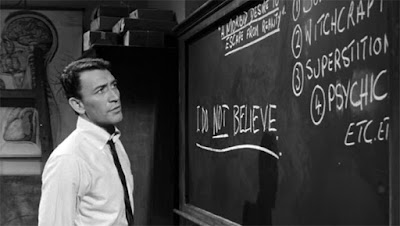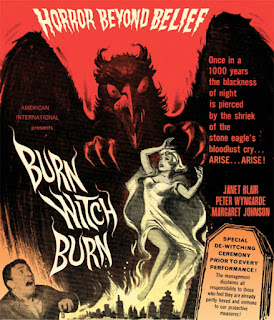Now Playing: Night of the Eagle (aka Burn, Witch, Burn; 1962)
Pros: Establishes a very spooky atmosphere of escalating menace.
Cons: Wraps the story up too abruptly and neatly.
Pros: Establishes a very spooky atmosphere of escalating menace.
Cons: Wraps the story up too abruptly and neatly.
Amidst all the sound and fury and scandal of American public life these days, a quiet revolution is brewing. Millennials are becoming increasingly skeptical of established institutions, especially organized religion, and are turning to alternative lifestyles and philosophies in droves.
One huge beneficiary of this sea change is the Wicca religion (or if you prefer, Pagan Witchcraft). Surveys indicate that Wicca membership has exploded from around 8,000 in 1990 to over a million today.
One of the aims of Wicca is to dispel the negative connotations that surround the word “witchcraft.” Another is to promote a better balance between humanity and nature that has been lost with the cult of technology. According to Wicca.com,
“Witchcraft in ancient history was known as ‘The Craft of the Wise’ because most who followed the path were in tune with the forces of nature, had a knowledge of Herbs and medicines, gave council and were valuable parts of the village and community as Shamanic healers and leaders. They understood that mankind is not superior to nature, the earth and its creatures but instead we are simply one of the many parts, both seen and unseen that combine to make the whole.”
 | |||
| I don't think this is the kind of image the Wiccans are going for... |
Assuming the surveys are accurate, a million believers is nothing to sneeze at. If there’s anything at all to the new white witchcraft, then I say more power to them -- a better balance between soulless technocracy and life-affirming spirituality is just what the witch doctor ordered. On the other hand, people being what they are, you can be damned sure that not all practitioners are of the positive, tree-hugging type.
A long time ago in the forgotten America of the mid-twentieth century, author Fritz Leiber anticipated the rise of Wicca with his story Conjure Wife. First published in 1943 in the pulp magazine Unknown Worlds, Conjure Wife conjures up a world in which women are secret witches, manipulating daily life with spells and incantations while the clueless men putter about, thinking that they are somehow masters of their own fate.
Over the years, Conjure Wife has gained a reputation as one of the better pieces of 20th century fantasy fiction. Its theme of secret, behind-the-scenes witchcraft in contemporary society has been taken up many times, most recently in the third and current seasons of the anthology TV series American Horror Story, featuring powerful witches.
The first film adaptation, Weird Woman (1944), was part of Universal’s Inner Sanctum series, and starred Lon Chaney Jr., Anne Gwynne and perennial Universal scream queen Evelyn Ankers. Witches Brew (1980), featuring Richard Benjamin, Terri Garr and Lana Turner, apparently took the material and made it much more whimsical and light-hearted. By all accounts, Night of the Eagle is the best adaptation of the lot. Filmed in the UK, Night combines scenes of comfortable, prosaic middle-class life with a creeping atmosphere of dark, unseen menace.
Night of the Eagle features yet another champion of science and reason, psychology professor Norman Taylor (Peter Wyngarde). The film opens with Taylor lecturing his class on the roots of superstition. On the blackboard he has written “I do not believe” -- words that he asserts can vanquish such forces as the supernatural, witchcraft, superstition, and psychic phenomena. Taylor sees such beliefs as futile attempts to “control one’s environment and the forces of nature.”
 |
| "Excuse me professor, is this going to be on the test?" |
It seems that while the couple were on sabbatical in Jamaica, Tansy had learned all about the powers of “conjure magic” from a local shaman. She senses that behind the humdrum facade of college life evil lurks, waiting to strike. She has placed all kinds of charms and talismans around the house in order to protect her oblivious husband.
When the good professor accidentally discovers the extent to which Tansy has larded the house with magical items, in a fit of self-righteous rationality he forces her to destroy them. Which is a big mistake. Suddenly, his once charmed life takes a big turn for the worse. A female student accuses him of sexual assault. Her boyfriend pulls a gun on him at his office. Worse yet, he’s no longer on the fast track to the department chair gig.
 |
| "Omigod, I forgot the bats' wings and eyes of newt in my grocery order!" |
Night of the Eagle very effectively takes the primeval/gothic horror elements of witchcraft, curses and talismans and relocates them to the most pedestrian of settings, a sleepy 20th century college community. The atmosphere of menace builds slowly at first. At a bridge party that Taylor and Tansy hold for their fellow faculty members and spouses, the conversation turns to campus politics and the open department chair position. Jealousies are revealed that, rather than petty, may be quite serious.
After Taylor pigheadedly strips himself and Tansy of their protections, the dark magic assaults begin in earnest. Fittingly, the secret malefactor uses the devices of the rational, technological age -- Taylor’s phone and tape recorder, and at the climax, the college’s PA system -- to try to destroy the haughty professor.
In one very effective night scene at the Taylor house, the professor is listening to a tape recording of one of his lectures when a curious eerie trilling sound issues from the machine. Tansy realizes that it is something unnatural and evil, and switches off the recorder to Taylor’s consternation. No sooner has she dealt with recorder, than the phone rings. Panicked, she yells at her husband not to pick it up. He brushes her away and then frowns in confusion as the sound emanates even more loudly from the receiver.
 |
| "Whatever you do, DON'T ANSWER IT! It's AT&T trying to sell us their internet and home security bundle!" |
The eldritch assault using the technology of supposed science and reason crescendos at the climax, as the auditory black magic summoning is piped over the college’s PA system. This (apparently) animates the very medieval-looking stone eagles that are placed around the grounds and the buildings. One chases the now-terrified Taylor into his classroom, where, ironically, “I do not believe” is still seen on the blackboard.
Night of the Eagle is a very well-constructed, spooky ride up to this point, but there are a couple of knocks on it. First, the shadowy evil-doer is pretty obvious from the get-go. Secondly, the villain’s comeuppance is very abrupt, and the way it comes about is too blatantly ironic. (Another possible objection, if you won’t make allowances for the era in which the film was made, is the absurdity of women with magic powers deciding to use them exclusively for the benefit of their blundering men.)
Still, it’s a very decent entry in the familiar science vs. superstition meme. Film historian William K. Everson, in his enjoyable horror film survey Classics of the Horror Film (Citadel Press, 1974), called out some of the film’s weaknesses, but also praised it for “several chilling sequences,” and especially for Janet Blair’s acting. He also hilariously used the film as a cautionary case study in reading too much into directorial decisions:
"The occasionally somewhat erratic editing was at least partially attributable to the hero’s [Peter Wyngarde’s] insistence on wearing indelicately tight trousers, forcing the director to shoot him in extreme long shot or extreme closeup much of the time! (This trivia information is recorded only to prevent future auteurists from discovering a definite pattern to the photographic style, and determining that medium shots for the wife and none for the hero are metaphors symbolizing a lack of communication between the two!)" (p. 239)
 |
| Peter Wyngarde threatens to bust out of his skinny jeans as he runs in terror from a stone eagle. |
Where to find it: If you have Amazon Prime, you can stream Night of the Eagle right now, for free.


No comments:
Post a Comment